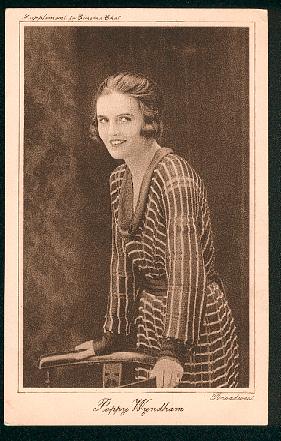EPoppylPoppysPoppyiPoppyePoppy Poppy‚PoppyÄPoppyúPoppyPPoppyoPoppypPoppypPoppyyPoppy‚PoppyÄPoppyĚPoppy PoppyMPoppyaPoppycPoppykPoppyaPoppyyPoppy (Elsie Mackay)

Actress, Interior Designer, and Aviation Pioneer. She is remembered as a British actress, interior decorator and aviator who died attempting to cross the Atlantic Ocean with Captain Walter Hinchliffe. She was regarded as a contemporary role model among women, with dark looks, graceful manner, and a habitually well-gowned and bejeweled appearance. Born Elsie Mackay in India, her father was James Mackay, 1st Earl of Inchcape of Strathnaver, a British colonial administrator in India who became chairman of the Peninsular and Oriental Steam Navigation Company, as a member of the Legislative Council of the Viceroy of India, and as a member of the Council of the Secretary of State for India. She was reportedly disinherited by her family after eloping with actor Dennis Wyndham in 1917, which was annulled in 1922. From 1919 through 1921 she appeared on the stage and screen as Poppy Wyndham. Her short, silent film career included appearances in “A Great Coup” (1919, as ‘Kate Hampton’), “Snow in the Desert” (1919), “Many a Slip” (1919, as ‘The Girl’), “Nothing But the Truth” (1920, as ‘Gwendolyn Gerald’), “A Dead Certainty” (1920, as ‘Pat Stone’), “The Town of Crooked Ways” (1920, as ‘Queenie Clay’), “The Tidal Wave” (1920, as “Carmen Hale’/’Columbine’), and “A Son of David” (1920, as ‘Esther Raphael’). In 1919 she married British actor Lionel Atwill (divorced in 1928) and appeared with him in the Broadway plays “Another Man’s Shoes” (1918), “As You Like It’ (1919, as ‘Rosalind’), “Clarence” (1919, as ‘Violet Pinney’), “The White-Faced Fool” (1922), “Poldekin” (1920, as ‘Maria’), “Deburau” (1920, as ‘Marie Duplssis’), and “The Comedian” (1923, as ‘Jacqueline’). After her marriage to Wyndham was annulled, she returned to her family and developed a career as an interior decorator, creating lavish interiors, state rooms and public spaces for her father’s shipping line. In 1923 she launched the RMS Maloja, and went on to design much of the interiors for the four P&O “R” class ships of 1925, the SS Rawalpindi, SS Ranchi, SS Ranpura and SS Rajputana, plus the RMS Viceroy of India in 1927. In 1923 she took up flying, gaining her pilot’s license at the De Havilland Flying School in England, and expressed a determination to be the first woman to fly the Atlantic Ocean. A daring woman, she was renowned for driving her Rolls Royce at great speed, galloping her horses, and being a familiar sight in her Avro biplane in the skies over the English skies at South Ayrshire and Wigtownshire. She was even daring enough to participate in an “outside loop,” the most dangerous of all stunts in air, with Captain E.C.D. Herne as her pilot. During this maneuver, her safety-strap broke but she clung to bracing wires while her body swung outside the plane. She was one of the first women in England to gain her Royal Aero Club pilot’s license and was later elected to the advisory committee of pilots to the British Empire Air League. To achieve her transatlantic ambition, she bought a single-engine Stinson Detroiter aircraft, naming it the ‘Endeavour’. At 8:35 A.M. on March 13, 1928 the aircraft departed from RAF Cranwell, Lincolnshire, England. Approximately 5 hours later, at 1.30 P.M., the Chief lighthouse keeper at Mizen Head on the south west coast of Cork, Ireland saw the monoplane over the village of Crookhaven, on the great circle course for Newfoundland. A French steamer, the SS Josiah Macy, later reported seeing the aircraft still on course, but nothing else is known and they vanished. Her body and that of Captain Hinchliffe was never recovered. A crowd of 5,000 is reputed to have waited for them at Mitchel Field, on Long Island, New York. In December 1928, a single piece of identifiable undercarriage (a wheel with a serial number on it) washed ashore in north west Ireland. She is commemorated by a stained glass window in the chancel of Glenapp Church in the parish of Ballantrae, Ayrshire, Scotland. Her financial legacy was the Elsie Mackay Fund, a ¬£500,000 trust that was left to the British nation on December 12, 1928, for 50 years and used to help pay off the country’s national debt. (bio by: William Bjornstad) ¬†Family links: ¬†Spouses: ¬†Douglas Wyndham (1887 – ____) ¬†Lionel Atwill (1885 – 1946)
Born
- January, 01, 1970
- India
Died
- March, 03, 1928

